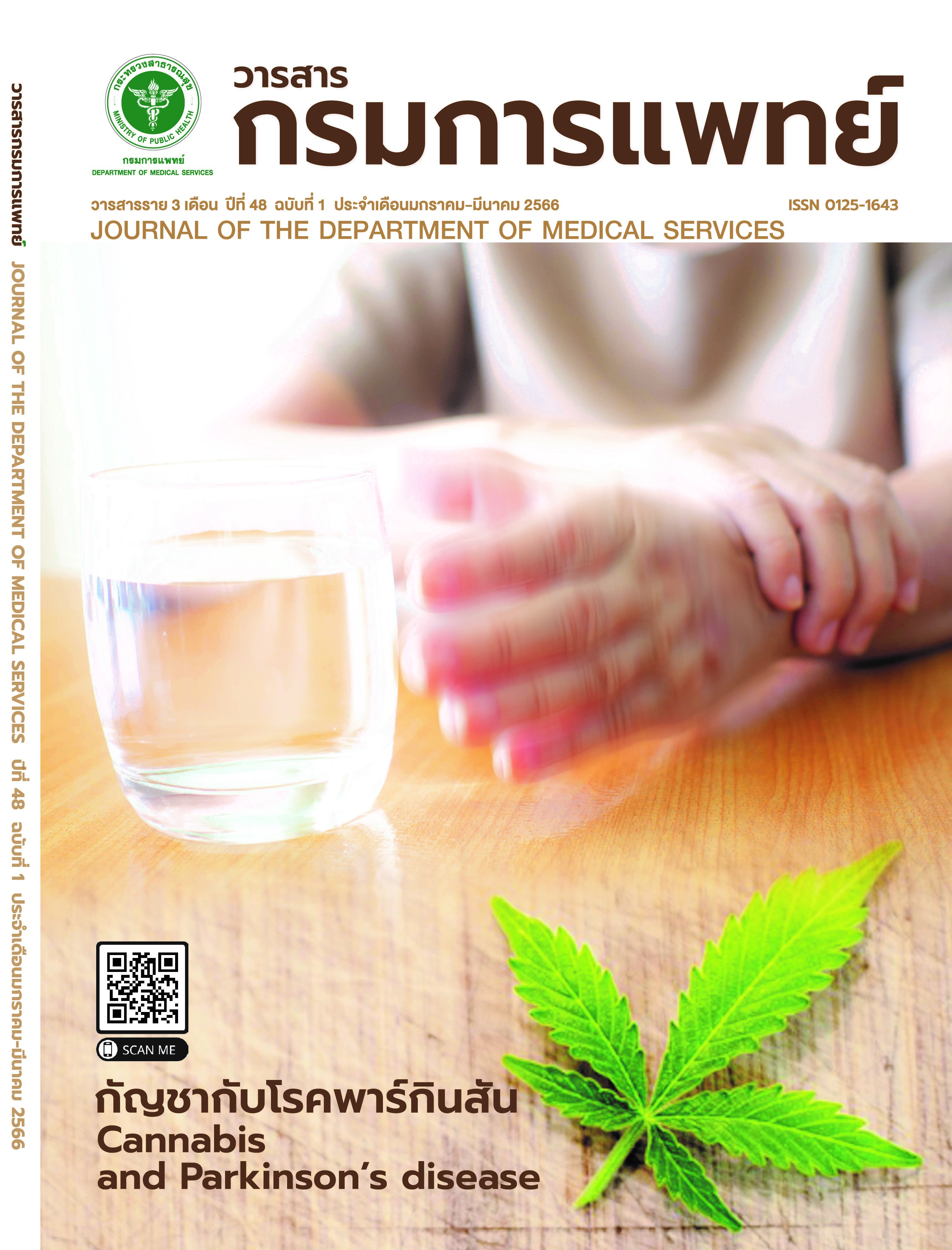The Effect of Tranexamic Acid to Reduce Blood Loss at 2 Hours Postpartum in Parturients with Anemia after Vaginal Delivery: A Double-blind Randomized Controlled Trial
Keywords:
Tranexamic acid, Parturients with anemia, Vaginal delivery, Double-blind ramdomized controlled trialAbstract
Background: Postpartum hemorrhage is an emergency and life-threatening symptom to postpartummothers. Those with anemia have an increased risk of postpartum hemorrhage at 50% compared to normalpregnancy. Objectives: To examine the effectiveness of Tranexamic acid for reducing blood loss 2 hourspostpartum in women with anemia after vaginal delivery. Method: A Double-blind Randomized Controlled Trialstudy was conducted. The total sample size was 80 equally distributed in both groups. Inclusion criteria: ≥ 37weeks of gestation, singleton pregnancy, planned vaginal delivery, and hematocrit at delivery room < 33 %.A study group received 1 g of tranexamic acid (20 mL in volume) and the control group received 0.9% NSS 20 ml.The study was conducted between November 2021 and March 2022. The primary outcomes were to compare themean blood loss and hematocrit values 2 hours after birth. The secondary outcomes were to examine the incidenceof postpartum hemorrhage and adverse events. Statistics were analyzed using the Chi-square test and independentt-test. Results: There were no statistical differences in age, number of pregnancies, parity, gestational age, hematocrit,perineal incision, and birth weight of both groups. The mean blood loss was significantly lower in the study groupthan in the control group (175.48 ml ± 110.90 ml and 368.13 ml ± 299.70 ml, p < .001). There were no statisticaldifferences in adverse events of both groups. Conclusions: Tranexamic acid 1 g intravenously effectively reducesblood loss at 2 hours postpartum in parturients with anemia after vaginal delivery.
References
World Health Organization. Trends in Maternal Mortality: 2000to 2017: Estimates by WHO, UNICEF, UNFPA, World Bank Groupand the United Nations Population Division, Geneva, Switzerland;2019.
Department of Health Ministry of Public Health. Situation analysisof Thai maternal mortality in the frst 6 months [Internet]. 2021.[cited 2021 Sep 15]. Available from https://hp.anamai.moph.go.th/ web-upload/ 4xceb3b571ddb 70741ad132d75876bc41d/tinymce/ OPDC/OPDC2564-S/IDC1_6/ opdc_2564_IDC1-6_02.pdf.
American College of Obstetricians and Gynecologists. ACOGpractice bulletin: clinical management guidelines forobstetrician-gynecologists number 76, october 2006: postpartumhemorrhage. Obstet Gynecol 2006; 108: 1039–47.
Royal College of Obstetricians and Gynecologists of Thailand.Clinical Practice Guideline Prevention and Managementof Postpartum Hemorrhage [Internet]. 2020. [cited 2021Sep 10]. Available from http://www.rtcog.or.th/home/wpcontent/uploads/2020/09/OB-63-020-Pre vention-andManagement-of-Postpartum-Hemorrhage.pdf.
Panyakhamlert K. Postpartum Hemorrhage. In: Thongsong T,editor. Obstetrics. 5th ed. Bangkok: Lakshmi Rung CompanyLimited; 2012.
Srisuphandit K. Postpartum Hemorrhage. [Internet]. 2022. [cited2022 July 15]. Available from:https://w1.med.cmu.ac.th/obgyn/lessons/33365/.
Kavle JA, Stoltzfus RJ, Witter F, Tielsch JM, Khalfan SS, Caulfeld LE.Association between anaemia during pregnancy and blood lossat and after delivery among women with vaginal births in PembaIsland, Zanzibar, Tanzania. J Health Popul Nutr. 2008; 26:232-40.
Nair M, Choudhry MK, Choudhry SS, Kakoty SD, Sarma UC,Webster P, et al. On behalf of the IndOSS-Assam steeringcommittee association between maternal anaemia andpregnancy outcomes: a cohort study in Assam, India. BMJGlobal Health 2016; 1: e000026.
Chalermpolprapa P. Anemia and Pregnancy. Reg 6-7 Mrd J 2008;27: 667-74.
Central Database System for Medical Record of NakhonpathomHospital. [Intranet]. 2021. [cited 2021 Sep 10]. Available from:https://www.nkpthospital.go.th/.
Department of Health, Ministry of Public Health. Health datacentre for standard on maternal and child care service [Internet].2017 [cited 2021 Sep 28]. Available form: http://www.hpc.go.th/director/data/standardUpload/LR_profle_090217_105208.pdf.
Simonazzi G, Bisulli M, Saccone G, Moro E, Marshall A, Berghella V.Tranexamic acid for preventing postpartum blood loss aftercesarean delivery: a systematic review and meta-analysis ofrandomized controlled trials. Acta Obstet Gynecol Scand 2016;95:28–7.
Li C, Gong Y, Dong L, Xie B, Dai Z. Is prophylactic tranexamic acidadministration effective and safe for postpar tum hemorrhageprevention? A systematic review and meta-analysis. Medicine2016; 96:1.
Franchini M, Mengoli C, Cruciani M, Bergamini V, Presti F, Marano G,et al. Safety and effcacy of tranexamic acid for preventionof obstetric haemorrhage: an updated systematic review andmeta-analysis. Blood transfus 2018; 16, 329–37.
Department of Medical Services, Ministry of Public Health.Manual of standard obstetric practice. Policy Development andmedical strategy Ministry of Health; 2015.
Hasan CS, Alalaf SK, Khoshnaw SA. Tranexamic AcidAdministration for the Prevention of Blood Loss After VaginalDelivery in a High-Risk Pregnancy: A Double-blind RandomizedControlled Trial. Research squar 2021; 1: 6447.
McCormack PL. Tranexamic acid: a review of its use in thetreatment of hyperfbrinolysis. Drugs. 2012; 72:585-617.
Novikova N, Hofmeyr GJ, Cluver C. Tranexamic acid for preventingpostpartum haemorrhage. Cochrane Database Syst Rev. 2015.
Stortroen NE, Tubog TD, Shaffer SK. Prophylactic TranexamicAcid in High-Risk Patients Undergoing Cesarean Delivery: ASystematic Review and Meta-Analysis of Randomized ControlledTrials. AANA J. 2020; 88:273-81.
Xia Y, Griffths BB, Xue Q. Tranexamic acid for postpartumhemorrhage prevention in vaginal delivery: A meta-analysis.Medicine (Baltimore). 2020; 99:e18792.
El-Garhy ET, Mohamed AH, Hamdy A, Elshahat A, Elmagd IA,Allah Hamed MA. Tranexamic Acid for Prevention ofPostpartum Hemorrhage after Vaginal Delivery. The EgyptianJournal of Hospital Medicine 2018; 73: 6157- 64.
Satyavathi GAL, Chandrika K. Effcacy of tranexamic acid inpreventing postpartum hemorrhage in vaginal delivery. J ReprodContracept Obstet Gynecol 2019; 8: 3485-91.
Sirithunyalak T, Wuttibenjarussamee K, Sripipattanakul M,Tangsiriwatthana T. Single Dose of Intravenous Tranexamic Acidfor Reduce Blood Loss from Surgical Staging in EndometrialCancer: A randomized controlled trial. Thai Journal of Obstetricsand Gynaecology 2021; 29: 151-58.
Thongsong T, Sirichotiyakul S. Postpartum Hemorrhage in:Obstetrics Thongsong T 5th rev. ed. Bangkok: LuxameerungCo., Ltd; 2012.
Nandhini CC., Shanmugapriya. The role of parenteral tranexamicacid in reducing blood loss in normal labour vaginal births inPemba Island, Zanzibar, Tanzania. Int J Reprod ContraceptObstet Gynecol 2020; 26: 232-40
Downloads
Published
How to Cite
Issue
Section
License
Copyright (c) 2023 Department of Medical Services, Ministry of Public Health

This work is licensed under a Creative Commons Attribution-NonCommercial-NoDerivatives 4.0 International License.
บทความที่ได้รับการตีพิมพ์เป็นลิขสิทธิ์ของกรมการแพทย์ กระทรวงสาธารณสุข
ข้อความและข้อคิดเห็นต่างๆ เป็นของผู้เขียนบทความ ไม่ใช่ความเห็นของกองบรรณาธิการหรือของวารสารกรมการแพทย์



